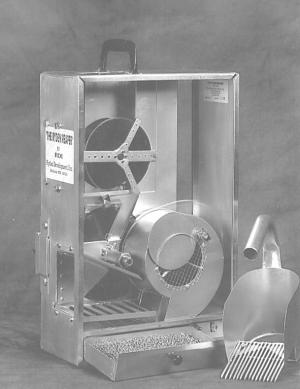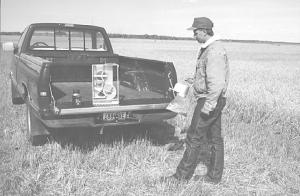Portable Grain Thresher - Sampler
"The most valuable commodity you have at harvest is time. Our new portable grain thresher eliminates the need to drive your combine back and forth to the field to get samples to test moisture," says Dave Ryden, inventor and manufacturer of the new "Ryden Reaper", a portable small grain sample thresher.
Ryden has been in the farm equipment business for many years and is also part of a five generation farming family. "I know the kind of presssures farmers face at harvest and I've always known there would be demand for a portable grain thresher that's fast, portable and easy to operate. We spent three years refining, testing, and patenting our unique new threshing process, which works better than any other portable threshing method ever developed."
The housing of the Ryden Reaper is made from lightweight aluminum with a clear Plexiglass panel on front. "We built it that way because I like to see how things work and I think most other farmers do, too," says Ryden.
The Ryden Reaper uses a 4-step method to thresh grain:
1) A toothed cylinder breaks up the heads into white caps after a sample is poured into the unit.
2) The second stage consists of a soft rubber disk that rolls the seed, peeling the hull off, much like you would do in your hand. "This method is so gentle it won't damage any kernels yet leaves many of the hulls still attached to the beards. You can adjust the threshing disk for different sized seeds, close enough to rub out even the small shriveled-up kernels that usually blow out the back of the combine," notes Ryden.
3) The third stage is a blower that has an adjustable shutter for regulating the air flow for proper separation of chaff and seed.
4) The last stage is a sieve, which works almost exactly like a sieve on a full-sized combine.
The unit can be electrically-powered off a 12-volt cigarette lighter, or you can crank it by hand. It comes with a hand-held "head stripper" that makes it easy to pull heads off stalks for threshing.
Ryden says it takes only a few minutes to collect a bag of heads, set up the Reaper, and thresh a sample. "Most moisture meters require only about 1/2 cup of seed so you can greatly cut down on the waste that you get when you use a combine to collect a sample."
In addition to moisture tests, you can use the unit for disease analysis, pre-harvest yield estimates, and protein and test weight information.
"Because it takes just a fraction of the time and expense involved in starting up your combine, we think it makes it easier to do a better job managing your crop," says Ryden, who sells a variety of ag products across the U.S. and Canada.
Sells for $395.
Contact: FARM SHOW Followup, Ryden Development, Inc., 102 E. Broad-way, Hallock, MN 56728 (ph 218 843-2252).

Click here to download page story appeared in.
Click here to read entire issue
Portable Grain Thresher - Sampler COMBINES Miscellaneous 21-2-30 "The most valuable commodity you have at harvest is time. Our new portable grain thresher eliminates the need to drive your combine back and forth to the field to get samples to test moisture," says Dave Ryden, inventor and manufacturer of the new "Ryden Reaper", a portable small grain sample thresher.
Ryden has been in the farm equipment business for many years and is also part of a five generation farming family. "I know the kind of presssures farmers face at harvest and I've always known there would be demand for a portable grain thresher that's fast, portable and easy to operate. We spent three years refining, testing, and patenting our unique new threshing process, which works better than any other portable threshing method ever developed."
The housing of the Ryden Reaper is made from lightweight aluminum with a clear Plexiglass panel on front. "We built it that way because I like to see how things work and I think most other farmers do, too," says Ryden.
The Ryden Reaper uses a 4-step method to thresh grain:
1) A toothed cylinder breaks up the heads into white caps after a sample is poured into the unit.
2) The second stage consists of a soft rubber disk that rolls the seed, peeling the hull off, much like you would do in your hand. "This method is so gentle it won't damage any kernels yet leaves many of the hulls still attached to the beards. You can adjust the threshing disk for different sized seeds, close enough to rub out even the small shriveled-up kernels that usually blow out the back of the combine," notes Ryden.
3) The third stage is a blower that has an adjustable shutter for regulating the air flow for proper separation of chaff and seed.
4) The last stage is a sieve, which works almost exactly like a sieve on a full-sized combine.
The unit can be electrically-powered off a 12-volt cigarette lighter, or you can crank it by hand. It comes with a hand-held "head stripper" that makes it easy to pull heads off stalks for threshing.
Ryden says it takes only a few minutes to collect a bag of heads, set up the Reaper, and thresh a sample. "Most moisture meters require only about 1/2 cup of seed so you can greatly cut down on the waste that you get when you use a combine to collect a sample."
In addition to moisture tests, you can use the unit for disease analysis, pre-harvest yield estimates, and protein and test weight information.
"Because it takes just a fraction of the time and expense involved in starting up your combine, we think it makes it easier to do a better job managing your crop," says Ryden, who sells a variety of ag products across the U.S. and Canada.
Sells for $395.
Contact: FARM SHOW Followup, Ryden Development, Inc., 102 E. Broad-way, Hallock, MN 56728 (ph 218 843-2252).
To read the rest of this story, download this issue below or click
here to register with your account number.








